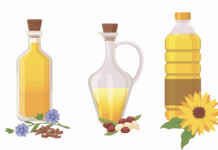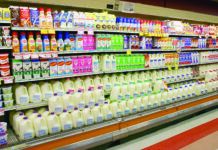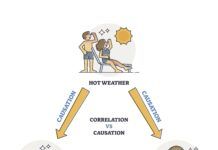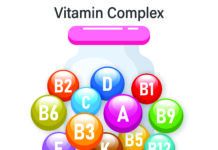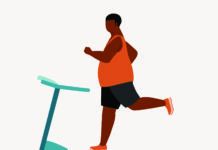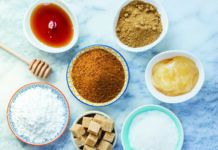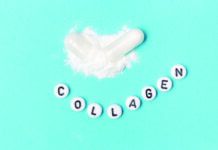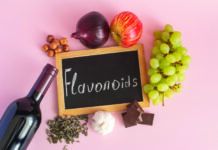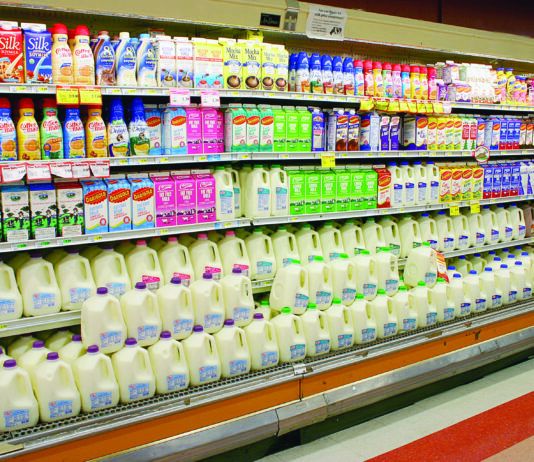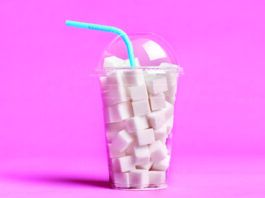Juice Bridges Veggie Gap
With Americans vegetable con- sumption dropping over the past decade, drinking your vegetables could help reach dietary goals. Thats the conclusion of a randomized trial funded in part, not surprisingly, by the makers of V8 vegetable juice. Scientists at the University of California-Davis assigned 90 volunteers to follow the Dietary Approaches to Stop Hyperten- sion (DASH) diet regimen while also consuming 0, 8 or 16 fuid ounces of vegetable juice daily. Despite being told to follow the DASH plan and receiving nutrition education, participants fell short of the goal of four daily servings of vegetables if not counting the juice. Across all groups, non-juice vegetable intake averaged 2.6 servings daily after 6 weeks and 2.3 servings after 12 weeks. But the groups also getting juice were able to close the gap. Researchers also looked at heart-health measures, which generally didnt change; pre- hypertensive participants, however, showed a signifcant decrease in blood pressure with higher vegetable and veg- etable juice intake. While eating whole vegetables remains preferable, research- ers concluded that juice is an effective and acceptable way for healthy adults to close the dietary vegetable gap.
Exercise Boosts Colds Defense
Your best defense this cold and fu season may be in the gym. Re- searchers at Appalachian State Univer- sity report that people who exercise more-as well as those who rate them- selves as highly ft-are less susceptible to upper-respiratory-tract infections. The study followed 1,002 adults over two 12-week periods in the fall and winter. Based on self-reported exer- cise, those who work out at least fve days a week suffered 43% fewer days with respiratory infections than those exercising no more than once a week. The one-third who rated their own ft- ness level the highest experienced 46% fewer sick days than the least-ft group. Even when they did get sick, frequent exercisers and the most ft suffered less- severe symptoms. Scientists suggested that even though the immune system returns to pre-exercise levels within a few hours, each workout may provide protection against pathogens that make the respiratory system vulnerable to infection. Other studies have actually shown that exercise may acutely sup- press immune response; this study may refect the effects of defensive responses over time.
Spend More, Eat Better?
P eople who eat more healthful diets really do spend more money on food. A new study compared the eating and grocery-spending habits of 78,191 women in the Nurses Health Study. Participants were divided into fve groups based on their scores on the Alternative Healthy Eating Index (AHEI), a system similar to the governments food pyramid. Compared to those with the lowest AHEI scores, the healthiest eaters spent 24% more on groceries-and had lower rates of angina, high blood pressure and type-2 diabetes. But researchers emphasized that your nutritional bang doesnt have to depend on the buck: Although spending more money was associated with a healthier diet, they wrote, large improvements in diet may be achieved without increased spending. The purchase of plant-based foods may offer the best investment for dietary health. (See our August 2010 Special Report for more on afford- able healthy eating.)
Red Yeast Rice: Buyer Beware
Laboratory tests have revealed strik- ing variability in the active ingredi- ents in Chinese red yeast rice, a supple- ment touted as an alternative to statin drugs for improving cholesterol. Among 12 popular brands, levels of monacolin, which is related to the prescription cho- lesterol medication lovastatin, ranged from 0.31 mg to 11.15 mg per capsule. The type of monacolin (K) thats most similar to lovastatin varied from 0.10 mg to 10.09 mg per pill. Four samples also contained citrinin, which can dam- age the kidneys. Researchers noted that, as a dietary supplement rather than a drug, red yeast rice is largely unregulated and lacks the quality controls of pre- scription medications. Therefore, physi- cians should be cautious in recommend- ing red yeast rice to their patients. Long used in China, red yeast rice has recently soared in sales in the US, up 80% from 2005 to 2008.
Extra Sugar Adds 475 Calories a Day
Nutrition experts have been warn- ing us to watch added sugars for at least a decade, but Americans are still struggling to follow that advice. Rachel Johnson, PhD, MPH, RD, of the Univer- sity of Vermont, incoming chair of the American Heart Associations nutrition committee, told a recent conference that Americans average 475 daily calories from added sugars. Thats far more than the AHAs recommended maximum of 100 daily calories from added sugars for women and 150 for men-and equivalent to a whopping 30 teaspoons a day. So we have a long way to go, Johnson told attendees at the American Dietetic Association Food and Nutrition Conference and Expo. Added sugars and solid fats total about 35% of the calories in the average diet, she added; the recommended maximum is 5%- 15%. To start scaling back on added sugars, Johnson advised simply avoiding sugary soft drinks, the source of about 36% of added sugars in the US diet. But dont worry about naturally occurring sugars, such as in milk or plain versions of cereal or yogurt, she said. Check the label to see if sugar in any form is listed among the ingredients.
Snorers Risk Metabolic Syndrome
Snoring may be more serious than just keeping your partner awake: A new study says that loud snorers are at nearly double the risk of develop- ing metabolic syndrome, a cluster of symptoms associated with diabetes and heart disease. University of Pittsburgh scientists studied 812 patients, ages 45-74, in an ongoing community heart- health study. Over three years, 14% developed meta- bolic syndrome. Those reporting loud snoring, diff- culty falling asleep and unsatisfying sleep were at much greater risk of met- abolic syndrome. Among a subset of 294 patients evalutaed for sleep apnea, however, only loud snoring remained signif- cantly associated with metabolic syndrome once the data were adjusted using the apnea- hypopnea index (AHI). Research- ers concluded that healthcare profes- sionals should consider common sleep problems as possible risk factors when assessing patients. It could also be that this is a case of reverse causation, since obesity- part of metabolic syndrome-can cause snoring and other sleep problems
Whole-Grain Products Soar
The US food packagers are getting the whole-grains religion. The market-research organization Mintel predicts that 2010 will wind up being the biggest year ever for whole-grain product launches. Through the third quarter, new products with whole- grain label claims already totaled 651. The Mintel report credited the Whole Grains Councils stamp labeling program as a driving force in con- sumer awareness of whole-grain health benefts: Since the introduction of the Whole Grain Stamp in 2005, more than 3,700 new whole-grain food products have been introduced. The percentage of new products carrying a whole-grain label claim has jumped from 2.3% in 2005 to 5.6% in 2010. The trend is even stronger among foods boasting that theyre all- natural, with nearly one in fve also touting whole grains. (See our complete guide to cooking and using whole grains in this issues Special Supplement.)
Green Tea Boosts Fullness
S ipping a cup of green tea with a meal may help you feel more full and less likely to go back for seconds. Thats the conclusion of Swedish researchers, who compared the post-meal effects of green tea with plain water. Their study failed, however, to confrm hopes that the antioxidant-rich tea would also moder- ate insulin sensitivity or glucose levels, helping to curb diabetes risk. Research- ers observed study participants for two hours after a meal, quizzing them on satiety and how full they felt. Not only did participants report feeling more full when accompanying the meal with a cup of green tea, they were also less interested in eating another mouthful of the same food. When washing down the meal with plain water, participants were later more of a mind to go for a second helping.
Consumers Mixed on High-Fructose Corn Syrup
Despite assur- ances from the Corn Refners Association-which recently peti- tioned the FDA to allow high-fructose corn syrup (HFCS) to be labeled corn sugar-the public remains wary about the common sweetener, accord- ing to another Mintel report. In a new survey, 35% of consumers said they avoid products containing HFCS and 84% think government should require companies to disclose the quantity of HFCS in products. Todays consum- ers are demanding transparency across the board, commented Krista Faron, lead innovation analyst at Mintel. And when it comes to an ingredi- ent as controversial as high-fructose corn syrup, the majority of Americans clearly want complete information that will help them make informed purchase decisions. By a 45%-35% margin, however, those surveyed op- posed government limits on HFCS use. And 64% of consumers still think the sweetener is OK in modera- tion-an opinion that most experts, pending further research, would prob- ably agree with.
Nutrition Facts Coming for Meat
Wheres the beef? Or, rather, whats in the beef? Answers to your questions about the nutritional content of meats will be easier to come by next year. The US Department of Agriculture (USDA) announced that it will require those familiar Nutrition Facts labels be placed on most meat packages or made available to consumers at the point of purchase as of Jan. 1, 2012. The new rule will affect 40 of the most com- monly purchased cuts of beef, pork, poultry and lamb. Although nutrition labels have been required on most food packages since 1993, labeling of meats remained voluntary. Agriculture Sec- retary Tom Vilsack commented, It is appropriate for us to provide as much concrete information to consumers as we possibly can, without overwhelming them, so they can make good solid deci- sions about how many calories theyre consuming and how much activity they need. A spokesman for the American Meat Institute, which did not oppose the changes, said consumers will fnd some pleasant surprises on the new labels, since many supermarket shop- pers arent aware of the many lean choices in the meat case.

